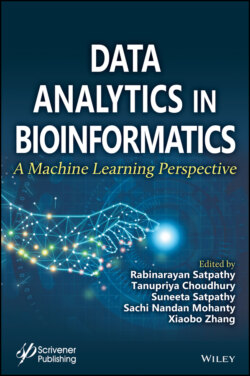Читать книгу Data Analytics in Bioinformatics - Группа авторов - Страница 28
1.9 Neural Networks
ОглавлениеThe Artificial Neural Network (ANN) was invented by Frank Rosenblatt in 1958 [91]. They are inspired by biological neural networks. It is a collection of connected nodes that are called neurons but artificial. The Original goal of Artificial Neural network (ANN), is to solve the problems as the human brain does [92–93]. It does so by taking the inputs, processing them, and calculating the output. Neural Networks can learn by themselves. The outputs that are generated by the neural networks are not limited to the input attributes provided by the user. It doesn’t require a database, rather it stores the input in its network. The general form of an artificial neural network is shown below in Figure 1.17 and its detailed version is shown in Figure 1.18. Its other name is the connectionist system. This system learns by considering examples and performing tasks. Neural Networks has its applications in various fields such as:
Figure 1.17 Neural network (general).
Figure 1.18 Neural network (detailed).
Speech Recognition [94]
Signature Verification Application [95]
Human face Recognition [96]
Character Recognition [97]
Natural Language Processing [98].
A basic execution procedure of a neural network [99] is presented in Figure 1.15. In general, it has consisted of three layers. These are the Input layer, Hidden Layer, and the Output layer. These layers are consist of neurons and these neurons and are connected among themselves. In this figure, the input layer contains the health parameters. Depending on the number of inputs received, the hidden processing layer will work to provide an output. Here, only two hidden processing layers are considered but could be any depending on the nature of the purpose of the machine. The outputs are attained and these outputs will act as an input for the next neuron and this process goes on forever. A detailed form of the neural network is explained briefly below with the help of Figure 1.18 for easy understanding.
In Figure 1.16, x1, x2, x3….xn are the inputs, and the weights they carry are represented by w1… wn. Their processing is done by the function F, where it performs summation with values up to n. After processing, the output is transmitted to the next neuron as an input. The AUC obtained after implementation of the neural network on the heart disease dataset is presented in Table 1.8. It shows that the model is performing excellently on the training dataset and outstanding on the testing dataset. The implementation is done on python (Google Colab).
Table 1.8 AUC: Neural network.
| Parameter | Data | Value | Result |
| The area under the ROC Curve (AUC) | Training Data | 0.8366730 | Excellent |
| Test Data | 0.9415238 | Outstanding | |
| Index: 0.5: No Discriminant, 0.6–0.8: Can be considered accepted, 0.8–0.9: Excellent, >0.9: Outstanding |
Some additional Points obtained from the implementation are also presented below:
Neural Score: 83.78
Neural Test Score: 90.24
Accuracy: 0.9024390.
Some other types of Neural Networks are available and listed below for reference:
Multilayer Perceptron [100]
Convolutional Neural Network [101]
Recursive Neural Network [102]
Recurrent Neural Network [103]
Long short term memory [104]
Sequence to Sequence Model [105]
Shallow neural Network [106].
